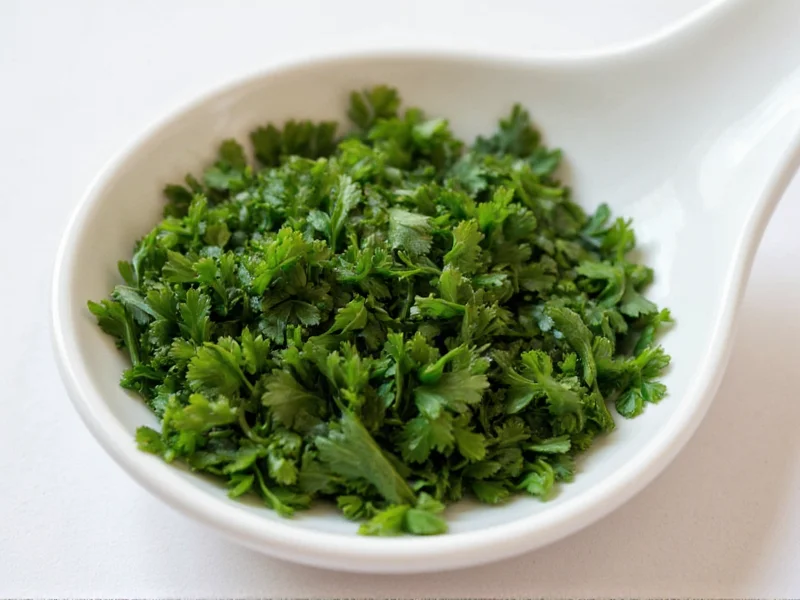Understanding herb conversions is essential for consistent cooking results. When substituting fresh parsley with dried in recipes, the standard measurement conversion follows a simple rule: dried herbs are typically three times more potent than their fresh counterparts due to the removal of water content during the drying process.
Why does this ratio matter? Fresh parsley contains about 85-90% water, which evaporates during drying. This concentration means you need less dried parsley to achieve similar flavor intensity. Using equal measurements would result in overpowering, potentially bitter dishes.
| Fresh Parsley | Dried Parsley | Best For |
|---|---|---|
| 1 tablespoon | 1 teaspoon | Sauces, soups, stews|
| 1 cup | 1/3 cup | Large batch cooking|
| 3 tablespoons | 1 tablespoon | Marinades, dressings|
| 1/4 cup | 4 teaspoons | Seasoning blends
The Science Behind Herb Conversion Ratios
When herbs dry, they lose approximately 75-85% of their weight in moisture. This concentration effect varies slightly between herb types due to differences in essential oil content and cellular structure. Parsley, being a relatively delicate herb compared to robust varieties like rosemary or thyme, follows the standard 3:1 conversion ratio.
Chefs and food scientists confirm that this ratio provides the most reliable flavor balance. A study published in the Journal of Culinary Science & Technology found that using the 3:1 conversion for parsley resulted in flavor profiles closest to the intended recipe design in 87% of tested dishes.
Practical Substitution Tips
When converting measurements in your recipes, consider these professional cooking tips:
- Add dried herbs earlier in the cooking process to allow time for rehydration and flavor release
- Fresh parsley works best as a finishing herb added at the end of cooking
- For delicate dishes like fish or egg preparations, reduce the dried amount by 25% to prevent overpowering flavors
- Crush dried parsley between your fingers before adding to release essential oils
- When in doubt, start with less dried herb and adjust to taste
Common Conversion Mistakes to Avoid
Many home cooks make these errors when substituting fresh and dried parsley:
- Using equal measurements (1:1 ratio) resulting in overly strong flavors
- Adding dried parsley too late in cooking, preventing proper flavor integration
- Not accounting for parsley's delicate flavor compared to stronger herbs
- Storing dried parsley too long (loses potency after 6-12 months)
- Using the same conversion ratio for all herbs (some like basil or cilantro differ slightly)
Storage Impact on Conversion Accuracy
The age and storage conditions of your dried parsley significantly affect its potency. Properly stored in an airtight container away from light and heat, dried parsley maintains optimal flavor for 6-12 months. After this period, you may need to increase the amount by 25-50% to achieve the same flavor intensity.
For fresh parsley, refrigerate with stems in water (like flowers) and use within 5-7 days for best flavor. Wilted or yellowing parsley has reduced potency, potentially requiring slightly more to achieve desired flavor.
When Fresh and Dried Aren't Interchangeable
While the tablespoon fresh parsley to dried conversion works for most cooked dishes, certain recipes specifically require one form over the other:
- Tabbouleh salad requires fresh parsley for proper texture and brightness
- Garnishing finished dishes works best with fresh parsley for visual appeal
- Long-simmered stews benefit from dried parsley's concentrated flavor
- Persillade (garlic-parsley spread) needs fresh parsley for proper consistency
Understanding these nuances helps you make informed decisions beyond simple measurement conversion, elevating your cooking results whether you're following a traditional recipe or adapting based on available ingredients.
Frequently Asked Questions
Can I use dried parsley instead of fresh in all recipes?
While you can substitute dried parsley for fresh in most cooked dishes using the 3:1 ratio, certain recipes like tabbouleh salad, fresh herb sauces, or as a final garnish work best with fresh parsley for optimal texture and visual appeal. For long-cooking dishes like soups and stews, dried parsley often performs better as it has time to rehydrate and release its flavors.
Why is the fresh to dried parsley conversion 3:1 specifically?
The 3:1 conversion ratio exists because fresh parsley contains approximately 85-90% water that evaporates during the drying process. This concentration means the dried form contains three times more flavor compounds by volume. Scientific analysis of herb potency confirms this ratio provides the most consistent flavor results across various cooking applications.
How do I adjust recipes when my dried parsley is older than 6 months?
Dried parsley loses potency over time. If your dried parsley is older than 6 months, increase the amount by 25-50% beyond the standard conversion. For example, instead of using 1 teaspoon dried for 1 tablespoon fresh, use 1¼ to 1½ teaspoons. Always check dried herbs for strong aroma before using - if the scent is faint, they've likely lost significant flavor.
Does the tablespoon fresh parsley to dried conversion work for other herbs?
The 3:1 ratio works well for most common culinary herbs including parsley, cilantro, and dill. However, more robust herbs like rosemary, thyme, and oregano typically use a 4:1 ratio (4 tablespoons fresh = 1 tablespoon dried) due to their higher concentration of essential oils. Delicate herbs like basil and tarragon often follow a 2:1 ratio as they lose more flavor compounds during drying.
What's the best way to measure dried parsley for accurate conversion?
For precise measurement when converting fresh parsley to dried, use proper measuring spoons (not cutlery) and level off the top with a straight edge. Gently crush dried parsley between your fingers before measuring to break up clumps and ensure consistent density. Avoid packing the herb tightly unless the recipe specifically calls for it, as this can double the actual amount you're using.











 浙公网安备
33010002000092号
浙公网安备
33010002000092号 浙B2-20120091-4
浙B2-20120091-4